#12 – India Pale Ale. During the last two weeks in Yorkshire and Wales we visited almost a dozen different pubs and tried at least 20 different tap ales. Furthermore, we continuously scoured the beer shelves of the local supermarkets for regional ales and stouts to taste. After all these samples, it was «India Pale Ale« (IPA) from various breweries, e.g. Thornbridge, that tickled my taste buds the most. It’s a beer with a very distinguishing flavour: on the one hand a sweet and flowery, perfume-like taste that reminds of jasmine or lychee, on the other hand a strong, hoppy bitterness, somehow reminiscent of wormwood or herb grapefruit. Delicious!
For the time being, this shall be the last episode of my little blog series about the numerous amenities suggesting a visit to Great Britain. But it’s going to be continued, I’m sure.
P.S. – Falls jemand unter den werten Lesern eine erschwingliche Bezugsquelle für importierte oder hierzulande gebraute India Pale Ales kennt (Online-Shop oder im Raum Hamburg), wäre ich sehr interessiert, davon zu erfahren!

Photo: © walknboston | Some rights reserved








